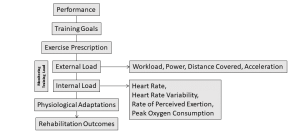Understanding Training Load Metrics in Rehabilitation
In rehabilitation, training load is a key variable that therapists adjust to achieve optimal therapeutic outcomes. This load can be categorized into two primary types: external load and internal load.
External Load (Demand)
External load refers to measurable aspects that exist outside the patient, such as the physical work load prescribed during rehabilitation. In the context of resistance training, external load is typically defined by the amount of weight lifted, but it can also be quantified through metrics such as total work completed or lifting velocity. External load may also be assessed using indicators, such as total distance walked, number of repetitions completed, or metabolic power. Although “metabolic power” suggests an internal process, it is derived from the speed-time profile, thus categorizing it as an external load indicator.
In the context of orthopaedic manipulative therapy, external loads refer to the physical work or demands placed by the clinician on a patient during an intervention. In other words, these external loads are specific forces generated by the clinician which are applied on a patient’s body segment by the clinician as part of an intervention. This includes manual techniques like stretching, joint glides, or thrusts, where the clinician physically manipulates the patient’s body to achieve a therapeutic effect. These clinician generated forces that are a part of external loads are quantifiable and can be specified in terms of grades of resistance felt by the clinician in the joints, amplitude of movement, and other measurable parameters.
Recent research emphasizes the importance of tailoring external load to individual patient needs and capabilities, utilizing technology such as wearable devices and smart equipment to provide real-time feedback. This allows therapists to adjust the rehabilitation plan dynamically, ensuring that the external load remains within the optimal range for each patient’s recovery.
Internal Load (Response)
Internal load, on the other hand, encompasses the body’s psychophysiological responses to the prescribed external load. This includes factors such as heart rate, perceived exertion, and hormonal responses, which reflect how the body is reacting to the external loads placed upon it.
In addition, patients generate muscular forces in response to the external loads placed on their body segments during therapeutic activities. For example, when a patient contracts their muscles to lift a weight, take a step on a treadmill, push against manual resistance from a clinician, or stabilize a joint while standing on an unstable surface, they are generating internal forces. These patient generated forces are a direct response to the external loads placed on their body segments during rehabilitation exercises or interventions.
Internal load measures are critical for understanding the effectiveness of the rehabilitation program and ensuring that patients are not overtraining or undertraining. Recent advancements in monitoring technologies, such as heart rate variability (HRV), blood lactate, electromyography (EMG) measurements, have provided deeper insights into internal load. These tools help therapists assess the individual psychophysiological responses during exercise, whether in single sessions or across multiple sessions, enabling a more personalized approach to rehabilitation.
Validity of Load Measures
There is no universally accepted gold standard for measuring either external or internal load; instead, various metrics can be employed to describe these loads and their effects. The validity of these measures is highly context-dependent. For example, while heart rate is a valid measure of internal load during endurance training, its applicability diminishes in resistance training settings. In a similar context, heart rate may be less reliable for assessing internal load during short-duration, high-intensity efforts compared to longer, steady-state activities.
Research studies have highlighted the need for a multifaceted approach to load monitoring (both external and internal), while combining subjective measures (like perceived exertion) with objective data (such as heart rate and power output) to gain a comprehensive understanding of how external and internal loads lead to improved outcomes. This approach allows for better management of training loads, ultimately enhancing patient outcomes in rehabilitation settings.

In summary, understanding and measuring both external and internal training loads are vital for effective patient rehabilitation. By leveraging recent research and technological advancements, therapists can create tailored rehabilitation programs that optimize therapeutic outcomes while minimizing the risk of injury or overtraining.
Reference:
Impellizzeri, F. M., Marcora, S. M., & Coutts, A. J. (2019). Internal and external training load: 15 years on. Int J Sports Physiol Perform, 14(2), 270-273.
McLaren SJ, Macpherson TW, Coutts AJ, Hurst C, Spears IR, Weston M. The Relationships Between Internal and External Measures of Training Load and Intensity in Team Sports: A Meta-Analysis. Sports Med. 2018 Mar;48(3):641-658. doi: 10.1007/s40279-017-0830-z. PMID: 29288436.
Impellizzeri, F. M., Shrier, I., McLaren, S. J., Coutts, A. J., McCall, A., Slattery, K., … & Kalkhoven, J. T. (2023). Understanding training load as exposure and dose. Sports Medicine, 53(9), 1667-1679.
Impellizzeri, F. M., Jeffries, A. C., Weisman, A., Coutts, A. J., McCall, A., McLaren, S. J., & Kalkhoven, J. (2022). The ‘training load’construct: why it is appropriate and scientific. Journal of Science and Medicine in Sport, 25(5), 445-448.
